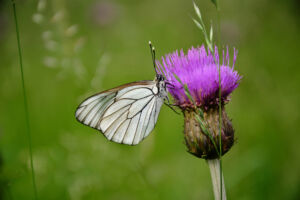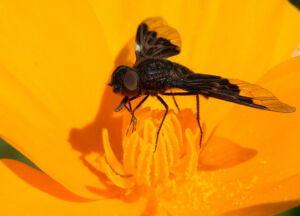The decline in insect populations has been documented for decades. In German nature reserves, too, insects are generally becoming fewer and a notably receding biodiversity can be observed. The research team of the “DINA” project has investigated the underlying reasons and has been looking out for possible solutions to protect insects. In a recent publication in the journal “Environmental Sciences Europe”, a team of authors that also includes scientists of ISOE – Institute for Social-Ecological Research presents recommendations for effective insect protection. One of the recommendations indicates that local dialog between nature conservation and agriculture is indispensable.
In order to stop the decline in biodiversity and halt the extinction of insects, great efforts are also needed in nature reserves. Even in these protected areas, the insect biomass has fallen alarmingly since the 1990s. The question of how this trend can be reversed was investigated by a transdisciplinary research team led by NABU – Nature and Biodiversity Conservation Union as part of the research project “DINA – Diversity of insects in nature conservation areas”. To this end, a unique survey concerning data on biodiversity and possible harmful causes was carried out at twenty-one representative observation sites. In addition to recording plant and insect diversity using innovative DNA analyses, data were also collected on land use and pesticide contamination of soils and insects.
The data showed that agricultural activity in the vicinity of nature reserves negatively impacts insect diversity in protected areas: If there is a high proportion of arable land in the vicinity of protected areas, a low insect diversity can be observed. In the same vein, the number of agrochemicals to which the insects are exposed scales with the proportion of arable land. Scientific analysis of the data has also shown that the negative influences of agricultural land situated in the vicinity of an observation site cannot be compensated for, even when it comes to larger nature conservation areas.
Key factor for reversing the trend of insect decline: local dialogues
In the recently published article “Recommendations for effective insect conservation in nature protected areas based on a transdisciplinary project in Germany”, Sebastian Köthe and other authors describe how the negative effects of fertilizers and synthetic pesticides can be avoided through more environmentally friendly land use in the vicinity of protected areas and how insect diversity can be sustained. At the same time, they advocate the cooperative development of solutions involving all stakeholders in order to compensate for possible agricultural yield losses and to offer mediation. As well as proposing measures to improve the effectiveness of protected areas, the scientists emphasize the importance of joint discussions about insect conservation and potential conflicts of interest between all stakeholders involved.
The authors see communication between stakeholders in agriculture and nature conservation, taking into account their joint commitment to insect conservation, as a key factor in reversing this trend. The DINA researchers therefore believe that suitable consulting and funding opportunities are needed to carry out local dialog processes geared towards developing consensual solutions with the aim to counter insect mortality in nature conservation areas.
The involvement of interest groups at local level could significantly facilitate conservation management. Included herein are environmental education and agroecological training for practitioners to improve the knowledge about effective insect conservation in stakeholders and the local population. “To enable broad societal support, biodiversity and its conservation should be established as part of education for sustainable development,” the authors conclude.
About the study
The study “Recommendations for effective insect conservation in nature protected areas based on a transdisciplinary project in Germany” was published in the open access journal Environmental Sciences Europe volume 35, Article number: 102 (2023) and was produced as part of the research project “DINA – Diversity of insects in nature conservation areas”. From 2019 to 2023 and funded by the Federal Ministry of Education and Research (BMBF), nine partner institutes led by NABU have conducted research on insect diversity in nature reserves as part of this transdisciplinary project. Flying insects were recorded and documented by the Entomological Association Krefeld and NABU volunteers at representative locations using malaise traps. The evaluation using modern molecular methods of species identification via DNA analyses (metabarcoding) was carried out by the Leibniz Institute for the Analysis of Biodiversity Change in Bonn. Vegetation analyses were carried out by the University of Kassel and trace substance analyses were done by the University of Koblenz-Landau. The IÖR (Leibniz Institute of Ecological Urban and Regional Development) analyzed geodata around the study sites. The social science analyses were carried out by IZNE (International Centre for Sustainable Development) at Hochschule Bonn Rhein-Sieg University of Applied Sciences. ISOE – Institute for Social-Ecological Research conducted dialog workshops in three nature conservation areas in Germany.
For more information please go to www.dina-insektenforschung.de
Recommendations for effective insect conservation in nature protected areas based on a transdisciplinary project in Germany. Sebastian Köthe, Nikita Bakanov, Carsten A. Brühl, Lisa Eichler, Thomas Fickel, Birgit Gemeinholzer, Thomas Hörren, Aleksandra Jurewicz, Alexandra Lux, Gotthard Meinel, Roland Mühlethaler, Livia Schäffler, Christoph Scherber, Florian D. Schneider, Martin Sorg, Stephanie J. Swenson, Wiltrud Terlau, Angela Turck & Gerlind U. C. Lehmann (2023). Environmental Sciences Europe volume 35 (102). https://doi.org/10.1186/s12302-023-00813-5
Scientific contact:
Dr. Florian Dirk Schneider
Research Scientist ISOE
Tel. +49 (0)69 707 6919-71
florian.schneider@isoe.de
www.isoe.de
Dr. Sebastian Köthe
Data Scientist NABU
Tel. +49 (0)172 160 7894
Sebastian.Koethe@NABU.de
Press contact:
Melanie Neugart
Tel. +49 69 707 6919-51
neugart@isoe.de
www.isoe.de
Contact:



